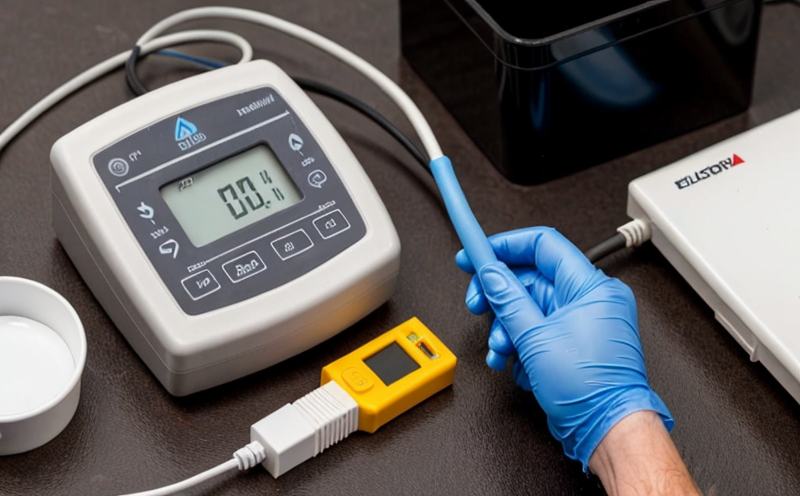ASTM G199 Electrochemical Noise Testing of Materials
The ASTM G199 standard provides a detailed procedure for evaluating the electrochemical noise (EN) produced by materials. This testing method is particularly useful in identifying and quantifying spontaneous galvanic corrosion currents that may occur between dissimilar metals or alloys when they are in contact with an electrolyte solution.
Electrochemical noise testing involves subjecting a material specimen to an alternating current (AC) potential at various frequencies, typically between 1 Hz and 50 kHz. The resultant noise voltage is recorded as a function of frequency. This allows for the detection of both high-frequency and low-frequency noise components that may indicate galvanic corrosion or other forms of localized corrosion.
The ASTM G199 method is widely used in industries such as aerospace, automotive, medical devices, and marine engineering, where the performance and reliability of materials are critical. The test helps in selecting materials with minimal electrochemical noise to ensure long-term stability and durability under corrosive environments.
Materials that undergo this testing include metals like stainless steel, aluminum alloys, copper-based alloys, and nickel-based alloys. These materials may be used in various applications where they come into contact with electrolytes, such as seawater or industrial chemicals.
The test setup involves a specimen holder to secure the material sample, an AC potential generator for applying the alternating current, and a noise measurement system capable of recording voltage fluctuations over time. The frequency range is adjustable to accommodate different test requirements.
Specimen preparation is critical in ASTM G199 testing. The material sample should be polished, cleaned, and free from any contamination or oxidation layers that could interfere with the test results. The surface area of the specimen plays a crucial role in determining the sensitivity and repeatability of the test.
The acceptance criteria for ASTM G199 are based on the noise voltage levels recorded at each frequency point. Typically, a noise threshold value is set, beyond which the material is considered to exhibit unacceptable electrochemical noise. This threshold can vary depending on the specific application and material being tested.
ASTM G199 testing offers several advantages. It allows for early detection of potential corrosion issues, enabling corrective actions to be taken before significant damage occurs. The test also provides valuable insights into the behavior of materials in various corrosive environments, helping to optimize design and manufacturing processes.
In conclusion, ASTM G199 electrochemical noise testing is a robust method for assessing the susceptibility of materials to galvanic corrosion. By providing accurate data on noise voltage levels, this test ensures that materials used in critical applications are reliable and durable over time.
Why It Matters
Electrochemical noise testing is essential for industries where material integrity and performance are paramount. The ASTM G199 method helps identify early signs of galvanic corrosion, which can lead to costly failures if left unaddressed.
- Durability: Ensures that materials used in critical applications remain stable and functional over their intended lifespan.
- Cost-effectiveness: By detecting potential issues early, businesses can avoid expensive repairs or replacements later on.
- Safety: Prevents accidents caused by material failures due to corrosion in high-risk environments like aerospace and automotive sectors.
The test results provide valuable data that can be used to improve product design, enhance manufacturing processes, and select materials with optimal electrochemical characteristics. This not only benefits the industry but also contributes to environmental sustainability by reducing waste and promoting the use of durable materials.
Why Choose This Test
Selecting ASTM G199 electrochemical noise testing is advantageous for several reasons. Firstly, it offers a standardized method recognized globally, ensuring consistent results across different laboratories and jurisdictions.
The test provides detailed insights into the behavior of materials in corrosive environments, which is crucial for industries where reliability is key. By identifying potential issues early, businesses can implement preventive measures to enhance product performance and safety.
ASTM G199 testing is particularly useful in sectors such as aerospace, automotive, medical devices, and marine engineering. These industries require materials that are highly resistant to corrosion and capable of maintaining their integrity under harsh conditions. The test results help manufacturers make informed decisions about material selection and design optimization.
The method also supports regulatory compliance by providing data that meets international standards like ISO, ASTM, EN, IEC, etc. This ensures that products meet the required quality and safety benchmarks, enhancing marketability and customer trust.
Environmental and Sustainability Contributions
ASTM G199 testing plays a crucial role in promoting environmental sustainability by ensuring that materials used in critical applications are reliable and durable. By identifying potential corrosion issues early, this test helps prevent accidents caused by material failures, which can have severe environmental impacts.
- Reduction of waste: Early detection allows for corrective actions before significant damage occurs, reducing the need for costly replacements or repairs.
- Enhanced durability: Selecting materials with minimal electrochemical noise ensures that products remain functional and reliable over their intended lifespan, minimizing the frequency of maintenance and replacement.
- Optimized design: The test results provide valuable data that can be used to improve product design and enhance manufacturing processes, leading to more efficient use of resources.
In conclusion, ASTM G199 electrochemical noise testing contributes significantly to environmental sustainability by ensuring the reliability and durability of materials, reducing waste, and promoting optimal resource utilization.





